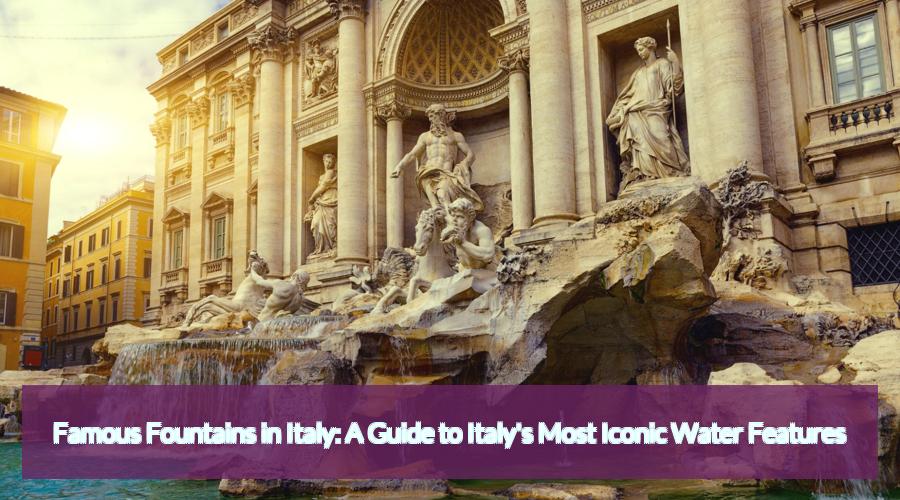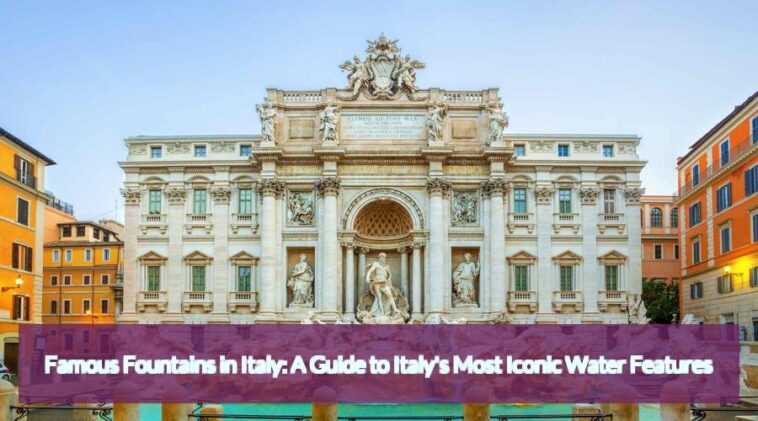Italy is home to some of the most iconic fountains in the world, each with its own unique story and charm. These fountains are not only visually stunning but also offer a glimpse into the country’s rich cultural heritage. Whether you’re a lover of art, history, or simply looking for a beautiful spot to take a photo, there is something for everyone in Italy’s famous fountains.
From the grandeur of the Trevi Fountain in Rome to the beauty of the Fountain of Neptune in Bologna, these fountains have captured the hearts and imaginations of people for centuries. Each fountain has its own unique character and history, reflecting the art, architecture, and culture of its respective city. Join us on a journey through some of Italy’s most famous fountains and discover the beauty and history they hold.

The Beauty and History of Italy’s Famous Fountains
One of the most famous fountains in Italy is the Trevi Fountain in Rome. This Baroque masterpiece was completed in 1762 and is known for its intricate design and dramatic size. It features the god Neptune, flanked by his tritons, in a chariot drawn by seahorses, as he rides through the sea. According to legend, throwing a coin into the fountain ensures that you will return to Rome one day.
Another well-known fountain in Italy is the Fountain of Neptune in Bologna. This fountain is a symbol of the city and is located in the central Piazza del Nettuno. The fountain was completed in the 16th century and depicts Neptune surrounded by sea creatures, including dolphins and mermaids. The fountain also has a political significance, as it was commissioned by the Pope to celebrate the city’s loyalty to the Catholic Church.
The Fountain of the Four Rivers is another famous fountain located in Rome. This Baroque fountain was designed by Gian Lorenzo Bernini in the 17th century and represents the four major rivers of the world: the Nile, the Ganges, the Danube, and the Rio de la Plata. The fountain is located in the Piazza Navona and is a popular tourist attraction due to its intricate design and historical significance.
Must-See Fountains in Rome, Italy
The most famous fountain in Rome is undoubtedly the Trevi Fountain, which attracts millions of visitors every year. This magnificent baroque fountain depicts the sea god Neptune, surrounded by sea creatures, and is said to bring good luck to those who throw a coin into the water. The Trevi Fountain is also featured in several movies, including “La Dolce Vita” and “Roman Holiday.”
Another must-see fountain in Rome is the Fountain of the Four Rivers in Piazza Navona. This baroque masterpiece was created by the famous sculptor Gian Lorenzo Bernini and represents the four major rivers of the world at that time: the Danube, the Ganges, the Nile, and the Rio de la Plata. The fountain is located in one of Rome’s most beautiful piazzas and is surrounded by impressive buildings and street artists.
The Fountain of the Naiads is another beautiful fountain in Rome, located in Piazza della Repubblica. The fountain was built in the late 19th century and depicts four nymphs riding on sea creatures, representing the four seasons. The fountain is illuminated at night, creating a beautiful atmosphere in the square.

Exploring Florence’s Iconic Fountains
One of the most famous fountains in Florence is the Fountain of Neptune. Located in the Piazza della Signoria, the fountain was commissioned by Cosimo I de’ Medici and designed by Bartolomeo Ammannati in the 16th century. The fountain features a statue of Neptune, the Roman god of the sea, surrounded by mythological sea creatures and dolphins.
Another iconic fountain in Florence is the Fountain of the Porcellino, located in the Mercato Nuovo. The fountain features a bronze boar statue, which is a symbol of good luck in Florence. Legend has it that rubbing the boar’s nose will bring good luck and a return trip to Florence.
The Fountain of the Innocents is another beautiful fountain in Florence, located in the Piazza della Santissima Annunziata. The fountain was designed by Francesco Sangallo in the 16th century and features a marble basin with bronze sculptures. The fountain’s central sculpture depicts the baptism of Christ by John the Baptist and is surrounded by other biblical figures.
The Splendor of the Trevi Fountain in Rome
The Trevi Fountain is one of the most famous fountains in Italy, if not the world. Located in the heart of Rome’s historic center, it is a symbol of the city’s grandeur and opulence. The fountain was designed by Italian architect Nicola Salvi in the 18th century and completed by Giuseppe Pannini in 1762. It stands 26 meters tall and 49 meters wide, making it the largest Baroque fountain in the city.
The fountain’s design features a magnificent sculptural composition of mythical figures and animals. The centerpiece is the figure of Oceanus, the god of the sea, riding a chariot pulled by sea horses and tritons. On either side of the chariot are allegorical figures representing abundance and health. The entire composition is set against a backdrop of rocks, water, and greenery.
According to legend, tossing a coin into the fountain ensures a return to Rome in the future. Visitors from all over the world flock to the Trevi Fountain to partake in this tradition, tossing over 3,000 euros worth of coins into the fountain each day. The money is collected by the city and donated to charity. The Trevi Fountain is a must-see attraction for anyone visiting Rome, and its beauty and grandeur continue to captivate visitors year after year.
Discovering the Fountains of Venice
The most iconic fountain in Venice is the Fontana di San Marco, located in the Piazza San Marco. This stunning fountain features a statue of the Archangel Gabriel on top of a marble pedestal, surrounded by four bronze horses. The fountain was originally built in the 14th century, but was rebuilt several times over the centuries. Today, it is one of the most popular attractions in Venice, and is especially beautiful at night when it is lit up.
Another must-see fountain in Venice is the Fontana del Nettuno, located in the Campo San Zaccaria. This fountain features a statue of Neptune, the god of the sea, surrounded by sea creatures and other mythological figures. It was built in the 16th century and is a popular spot for taking photos and people-watching.
The Fontana di Ca’ d’Oro is another beautiful fountain in Venice, located in the Cannaregio district. It features a statue of a young boy holding a fish, and is surrounded by four smaller fountains. The fountain was originally built in the 15th century, and was restored in the 19th century. It is a hidden gem that is often overlooked by tourists, but is well worth a visit.

The Majesty of the Fountain of Neptune in Bologna
The Fountain of Neptune in Bologna is one of the most iconic and majestic fountains in Italy. Located in Piazza del Nettuno, this fountain is a masterpiece of Italian Renaissance art and architecture. The fountain was built in the 16th century by the renowned Italian sculptor Giambologna, who is also famous for his other works of art such as the Rape of the Sabine Women.
The Fountain of Neptune depicts the god of the sea, Neptune, standing on a shell-shaped chariot, surrounded by a group of mythological sea creatures. The fountain is made of white marble and has intricate details that showcase the exceptional craftsmanship of Italian sculptors. The fountain is a symbol of power and wealth and was built to celebrate the marriage of Francesco d’Este, Duke of Modena, to Archduchess Maria Teresa of Austria.
The Fountain of Neptune is not just a work of art but also an important landmark in Bologna. It is located in the heart of the city and attracts tourists from all over the world. Visitors can admire the intricate details of the fountain, take pictures, and enjoy the beauty of the Piazza del Nettuno. The fountain is also illuminated at night, making it a perfect spot for a romantic evening stroll.
The Uniqueness of the Fountain of the Four Rivers in Rome
The Fountain of the Four Rivers (Fontana dei Quattro Fiumi) is one of the most iconic fountains in Rome and a masterpiece of Baroque art. Located in the Piazza Navona, the fountain was designed by the famous Italian sculptor Gian Lorenzo Bernini in 1651. The fountain depicts the four major rivers of the world known at the time: the Nile, the Ganges, the Danube, and the Rio de la Plata. The four river gods are shown supporting an obelisk, which symbolizes the triumph of Christianity over paganism.
Each of the river gods in the Fountain of the Four Rivers is depicted in a different position and expression, representing their respective rivers. The Ganges, the longest river in India, is represented with an oar in his hand, while the Rio de la Plata, the widest river in South America, is depicted holding a pile of coins. The Nile, the longest river in the world, is shown holding a covered head, symbolizing the mystery surrounding the river’s source. Finally, the Danube, the longest river in Europe, is represented leaning on a vase.
The Fountain of the Four Rivers is a true masterpiece of Baroque art, combining sculpture, architecture, and water in a stunning display of grandeur and opulence. The fountain has been a popular tourist attraction for centuries and continues to draw visitors from all over the world who come to admire its beauty and historical significance. Whether you are a lover of art, history, or simply want to experience the magic of Rome, a visit to the Fountain of the Four Rivers is an absolute must.

The Charm of the Fountain of the Moor in Padua
The Fountain of the Moor is a beautiful fountain located in the city of Padua, in northeastern Italy. This charming fountain is situated in the Piazza delle Erbe, the city’s main square, and it is one of the most popular tourist attractions in Padua. The fountain is known for its intricate details and beautiful design, and it has a rich history that is worth exploring.
The Fountain of the Moor was built in the 16th century and it is named after the bronze statue of a moor that stands at the top of the fountain. The statue is holding a dolphin, which symbolizes the power of the Venetian Republic over the seas. The fountain was designed by the famous Italian architect and sculptor, Tiziano Aspetti, and it was originally built to provide drinking water to the people of Padua.
Today, the Fountain of the Moor is admired not only for its historical significance, but also for its beauty. The fountain has a unique shape and is adorned with various sculptures and reliefs that depict scenes from Padua’s history. The water that flows from the fountain is crystal clear and adds to the overall charm of the square. Visitors to Padua should not miss the opportunity to visit this beautiful fountain and experience its unique charm.
The Intricacy of the Fountain of Diana in Rome
The Fountain of Diana is a beautiful fountain located in Rome, Italy. It is located in the heart of the Piazza del Popolo, one of Rome’s most famous squares. The fountain was built in the early 19th century and is named after Diana, the Roman goddess of the hunt.
The fountain features a central statue of Diana holding her bow and arrow, surrounded by four smaller statues representing the seasons. The intricate details of the statues and the overall design of the fountain make it a popular destination for tourists and locals alike.
In addition to its aesthetic appeal, the Fountain of Diana has a rich history. It was originally built to celebrate the restoration of the Aqua Claudia aqueduct, which brought water to Rome from the Aniene River. Today, it stands as a testament to the skill and creativity of the artists who built it, and a reminder of the importance of water in the city’s history.

The Magnificence of the Fountain of Triton in Rome
The Fountain of Triton, also known as Fontana del Tritone in Italian, is a famous Baroque-style fountain located in Rome, Italy. It was designed by the famous Italian sculptor, architect, and painter Gian Lorenzo Bernini in the mid-17th century. The fountain features a large central sculpture of Triton, the mythological Greek god of the sea, who is shown standing on a shell-shaped chariot pulled by sea horses.
The Triton Fountain is located in the Piazza Barberini, which is situated at the crossroads of three of Rome’s major streets. The fountain was commissioned by Pope Urban VIII in honor of his family, the Barberini, who owned the surrounding palace. The fountain was completed in 1642 and has been a popular attraction ever since. The fountain was later restored in the 18th century by the architect Francesco Borromini.
The Fountain of Triton is considered one of Bernini’s most important works. The sculpture of Triton is incredibly detailed, and the movement of the water around the fountain creates a dynamic effect. The sea horses that pull the chariot are also incredibly lifelike, adding to the sense of motion and energy in the fountain. The Triton Fountain is a must-see for anyone visiting Rome, and it is a testament to the incredible artistry and skill of Gian Lorenzo Bernini.
What is the most famous fountain in Italy?
The most famous fountain in Italy is the Trevi Fountain located in Rome.
Which Italian city is famous for fountains?
Rome is the Italian city famous for fountains. It has over 2,000 fountains, including famous ones like the Trevi Fountain, the Fountain of the Four Rivers, and the Fountain of Neptune.
What is the oldest fountain in Italy?
The oldest fountain in Italy is the Fountain of Neptune in Bologna, which was built in the 16th century.



